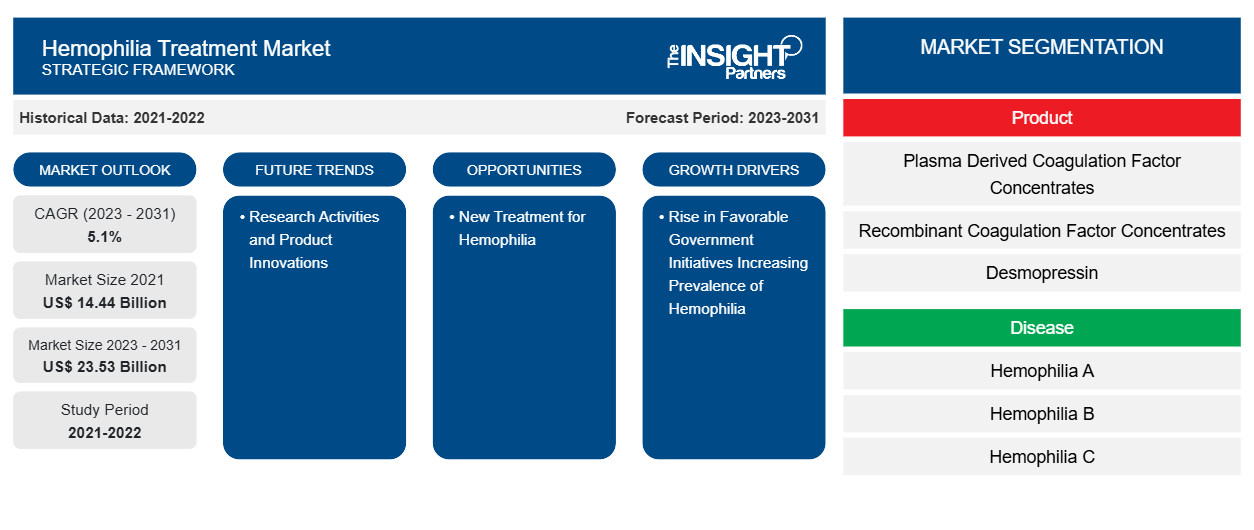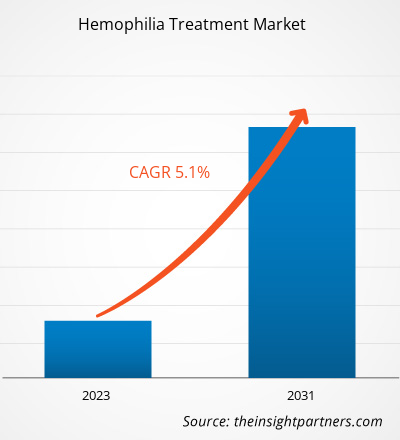The hemophilia treatment market size in 2021 stood at US$ 14.44 billion and is projected to reach US$ 23.53 billion by 2031 from US$ XX billion in 2023. The market is expected to register a CAGR of 5.1% in 2023–2031. AAV (adeno-associated virus) based gene therapy is a new treatment for hemophilia is likely to remain a key hemophilia treatment market trend.
Hemophilia Treatment Market Analysis
The market is being driven primarily by the presence of numerous players and various products in pipeline phases. The increase in R&D studies for haemophilia treatments, the increase in target population, and the prevalence of haemophilia contribute to the growth of the hemophilia treatment market. Furthermore, rising awareness of haemophilia disorders and increasing government funding for early identification in neonates are expected to drive market growth.
Hemophilia Treatment Market Overview
Hamophilia is a genetic bleeding disorder in which blood clotting factors are defective or lacking, causing internal and external bleeding. Significant technological advances in haemophilia treatment products have resulted in the availability of enhanced treatment alternatives for haemophilia management in the population. The demand for new haemophilia treatment options is increasing as the target population grows and the number of diagnostic procedures increases worldwide.
Customize This Report To Suit Your Requirement
You will get customization on any report - free of charge - including parts of this report, or country-level analysis, Excel Data pack, as well as avail great offers and discounts for start-ups & universities
Hemophilia Treatment Market: Strategic Insights

-
Get Top Key Market Trends of this report.This FREE sample will include data analysis, ranging from market trends to estimates and forecasts.
Hemophilia Treatment Market Drivers and Opportunities
Rise in Favorable Government Initiatives to Favor Market Growth
An increase in several government initiatives is expected to boost healthcare industry growth over the forecast period. Organizations such as the World Hemophilia Organization and governments of several countries carry out awareness and diagnosis programs. For instance, Health Resources and Services Administration (HRSA) Maternal and Child Health Bureau (MCHB), with funding from HRSA, hemophilia treatment center (HTCs) deliver critical, complete multi-disciplinary facilities, such as physical therapy charges, social work, and case management services that are not characteristically enclosed by insurance. Government efforts to improve public health and treat deprived people will boost the growth of the hemophilia treatment market.
Research Activities and Product Innovations
Over the last five years, many hemophilia treatment products that are currently used in several disciplines have been developed. For instance, in February 2020, Novo Nordisk introduced an antihemophilic product, Esperoct, to reduce hemophilia effect in adults and children with hemophilia A.
Hemophilia Treatment Market Report Segmentation Analysis
Key segments that contributed to the derivation of the hemophilia treatment market analysis are product, disease, treatment type, therapy, and end user.
- Based on product, the hemophilia treatment market is divided into plasma derived coagulation factor concentrates, recombinant coagulation factor concentrates, desmopressin, and antifibrinolytic agents. The market is further divided on the basis of plasma derived coagulation factor concentrates into factor VIII, factor IX, factor XII, activated prothrombin complex concentrate, and von willebrand factor. The recombinant coagulation factor concentrates segment is further segmented into factor VIII and factor IX. The plasma derived coagulation factor concentrates segment held a larger market share in 2023.
- By disease, the market is segmented into hemophilia A, hemophilia B, and hemophilia C. The hemophilia A segment held the largest share of the market in 2023.
- In terms of treatment type, the market is bifurcated into on-demand and prophylaxis. The prophylaxis segment dominated the market in 2023.
- In terms of therapy, the market is bifurcated into replacement therapy, ITI therapy, gene therapy, and antibody therapy. The prophylaxis segment dominated the market in 2023.
- By end user, the market is segmented into hospitals & clinics, hemophilia treatment centers, and ambulatory surgical centres. The hospitals and clinics segment held the largest share of the market in 2023.
Hemophilia Treatment Market Share Analysis by Geography
The geographic scope of the hemophilia treatment market report is mainly divided into five regions: North America, Asia Pacific, Europe, Middle East & Africa, and South & Central America.
North America has dominated the hemophilia treatment market. Factors such as the increasing number of surgical procedures, improvement in the healthcare infrastructure, and the availability of technological advancements in the region are leading to the growth of the hemophilia treatment market in North America.
Hemophilia Treatment Market Regional InsightsThe regional trends and factors influencing the Hemophilia Treatment Market throughout the forecast period have been thoroughly explained by the analysts at The Insight Partners. This section also discusses Hemophilia Treatment Market segments and geography across North America, Europe, Asia Pacific, Middle East and Africa, and South and Central America.
Hemophilia Treatment Market Report Scope
| Report Attribute | Details |
|---|---|
| Market size in 2021 | US$ 14.44 Billion |
| Market Size by 2031 | US$ 23.53 Billion |
| Global CAGR (2023 - 2031) | 5.1% |
| Historical Data | 2021-2022 |
| Forecast period | 2023-2031 |
| Segments Covered |
By Product
|
| Regions and Countries Covered |
North America
|
| Market leaders and key company profiles |
|
Hemophilia Treatment Market Players Density: Understanding Its Impact on Business Dynamics
The Hemophilia Treatment Market is growing rapidly, driven by increasing end-user demand due to factors such as evolving consumer preferences, technological advancements, and greater awareness of the product's benefits. As demand rises, businesses are expanding their offerings, innovating to meet consumer needs, and capitalizing on emerging trends, which further fuels market growth.

- Get the Hemophilia Treatment Market top key players overview
Hemophilia Treatment Market News and Recent Developments
The hemophilia treatment market is evaluated by gathering qualitative and quantitative data post primary and secondary research, which includes important corporate publications, association data, and databases. The following is a list of developments in the market for hemophilia treatment:
- The Japanese Ministry of Health, Labor, and Welfare (MHLW) has granted marketing authorization for ALTUVIIIO [Antihemophilic Factor (Recombinant), Fc-VWF-XTEN Fusion Protein], a first-in-class, high-sustained factor VIII replacement therapy. ALTUVIIIO is indicated for control of bleeding tendency in patients with hemophilia A (factor VIII deficiency). ALTUVIIIO was also recently approved by the Taiwan Food and Drug Administration for treatment of adults and children with hemophilia A on August 31, 2023. (Source: Sanofi, Press Release, 2023)
- Takeda Pharmaceutical Company Limited (“Takeda”) announced the U.S. availability of myPKFiT for ADYNOVATE [Antihemophilic Factor (Recombinant), PEGylated], a web-based software and mobile application that is the first and only pharmacokinetic (PK)-dosing software approved by the U.S. Food and Drug Administration (FDA) for hemophilia A patients 12 and older and weighing at least 29 kg treated with ADYNOVATE. (Source: Takeda Pharmaceutical Company Limited, Press Release, 2020)
Hemophilia Treatment Market Report Coverage and Deliverables
The “Hemophilia Treatment Market Size and Forecast (2021–2031)” report provides a detailed analysis of the market covering below areas:
- Market size and forecast at global, regional, and country levels for all the key market segments covered under the scope
- Market dynamics such as drivers, restraints, and key opportunities
- Key future trends
- Detailed PEST/Porter’s Five Forces and SWOT analysis
- Global and regional market analysis covering key market trends, major players, regulations, and recent market developments
- Industry landscape and competition analysis covering market concentration, heat map analysis, prominent players, and recent developments
- Detailed company profiles
- Historical Analysis (2 Years), Base Year, Forecast (7 Years) with CAGR
- PEST and SWOT Analysis
- Market Size Value / Volume - Global, Regional, Country
- Industry and Competitive Landscape
- Excel Dataset
Recent Reports
Testimonials
Reason to Buy
- Informed Decision-Making
- Understanding Market Dynamics
- Competitive Analysis
- Identifying Emerging Markets
- Customer Insights
- Market Forecasts
- Risk Mitigation
- Boosting Operational Efficiency
- Strategic Planning
- Investment Justification
- Tracking Industry Innovations
- Aligning with Regulatory Trends





















 Get Free Sample For
Get Free Sample For